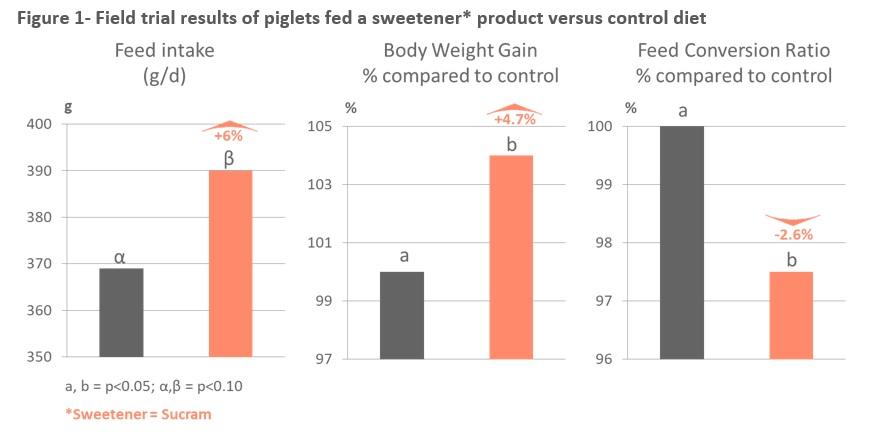Taste enhancers optimizing performance on piglets through the gut health
Published: March 28, 2019
By: Mathilde RAMILLIEN. Product Manager Palatants – Flavorist
Considering the impact of taste enhancers
Commonly used in feed to enhance appetite by providing an attractive taste, the function of taste enhancers is to target the receptors of the 5 main tastes, namely: sweet, salty, bitter, acid and umami. Many tests and studies have demonstrated the positive effect on the condition of animals and in fine on performance.
It is known that a good taste enhancer improves the taste of feed and stimulate consumption. However, some molecules, such as monosodium glutamate (umami taste), present in some products, are known to trigger a hormonal secretion (CCK hormones) reducing appetite of animals. That's why Pancosma focuses on sweet flavor enhancers that do not contain umami molecules, such as SUCRAM® products which trigger sweet taste receptors. Deeply involved in research on gut health, the Swiss company present worldwide has developed a solution to improve the performance of animals by stimulating their appetite while taking care of their intestinal health.
These sweeteners trigger the sweet taste receptors (T1R2 and T1R3) mainly known to be located on the tongue of animals. Nevertheless, they have also been identified in the digestive tract where they play a very important role. Giving special importance to the intestinal physiology of animals, Pancosma brings its expertise and know-how by publishing data from mechanistic and fundamental research on the gastrointestinal tract.
Looking at the molecular physiology effects of the products, a strong impact on the gut has been described including gut sensing, gut immunity and gut microbiota. This highlighted the “gut effects” which is promoted as ‘Intelligent Gut Action’ (IGA). The described effects at the intestinal level are: the release of glucagon-like peptide 2 (GLP-2) and the expression of the glucose transporter (SGLT-1). The GLP-2 hormone is involved in tissue repair and increases blood flow to the gut, which can improve digestion and absorption of nutrients in addition to preventing or repairing damages. And the expression of SGLT-1 will promotes glucose absorption.
Therefore the use of a high intensity sweetener improves the integrity of the animal's gut and the absorption of nutrients.
Pancosma has an enriched knowledge in the development of sweeteners formulas thanks to the expertise of the in-house flavorists, experts panelists and animal research focus. These patented and well-balanced formulas combining sweeteners, potentiators and enhancers are branded under the SUCRAM® brand. This combination ensures optimal performance beyond traditional sweeteners.
As this type of additive is usually incorporated at low doses, it is essential that its quality and technology ensure a good mixability and even dispersion in feed. Therefore the technical constraints are crucial for an optimum effect: homogeneity, flowability, particle size distribution. This is the reason why all SUCRAM® formulas are produced to have excellent physical properties: 100% soluble, free-flowing, homogeneous, dust-free, non-caking and extremely stable. These products are 100% soluble, fluid, homogeneous, dust free, free from agglomeration and extremely stable. SUCRAM® is used to improve taste, mask bitterness and stimulate animals appetite.
Improvements on animals’ performance obtained with SUCRAM® products
Besides good quality feed, favorable housing conditions, climate and farm management a fast gut development and a good gut health are key parameters in the growing process of animals. To maximize this development from the earliest stages of the animals’ life, the diet should be attractive and palatable. A sweetened feed is more likely to be accepted by young animals when solid feed are offered to them for the first time.
Once the feed is ingested, SUCRAM® will first be detected by receptors on the tongue and will give the feed a pleasant taste. Then it will be able to achieve its effects on the gut.
Independent field trials of 384 weaned pigs revealed that the high-quality sweetening product of increased feed consumption (+ 6%), body weight gain (+ 4.7%), and improved feed conversion ratio (-2.6%) (see Figure 1).

More recently, a study has demonstrated the positive effect of SUCRAM® on Lactobacillus population. This is the first report of a pre-biotic like effect of SUCRAM® influencing commensal gut microbiota. Sweeteners can be used in a wide range of applications for many types of feed, such as creep feed, prestarter, starter, milk replacer, drinking water and for several species including piglets, pigs, sows, calves, beef and dairy cows. Formulations must be properly selected according to the targeted species and legislation of the area. For example a sweetener used for sows in Europe cannot be based on sodium saccharin. To fit these needs the SUCRAM® portfolio also contains products based on natural sweeteners. Research projects to understand the specificities of sweet taste receptors in swine are ongoing. Pancosma emphasizes on understanding the underlying mechanisms of the gut effect of sweeteners in swine, in order to offer new solutions to the market.
Continuously providing innovative and adapted solutions
In addition to sweet taste receptors the gut also has the ability to detect other taste compounds (umami and bitter) non-nutrients such as phytonutrients, including capsaicin (from chili peppers) and cinnamaldehyde (from cinnamon).
Pancosma propose a large range of products such as flavors, phytonutrients or minerals that can be combined in complex and complete solutions called TakTik® products. These solutions bring together Pancosma’s knowhow by combining the strength of each ranges such as flavors, sweeteners, phytonutrients and minerals.
Want to learn more? Contact our expert below
Related topics
Authors:
ADM Aditivos
Recommend
Comment
Share

Would you like to discuss another topic? Create a new post to engage with experts in the community.






.jpg&w=3840&q=75)